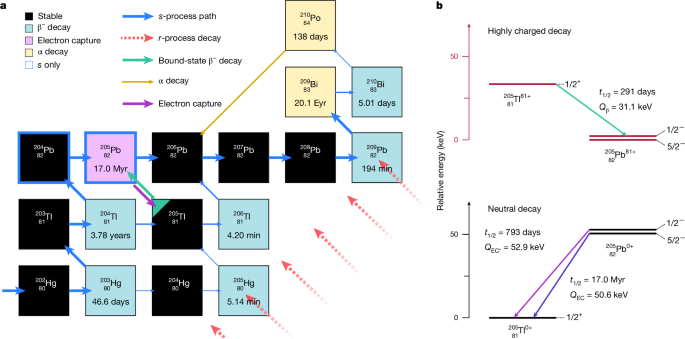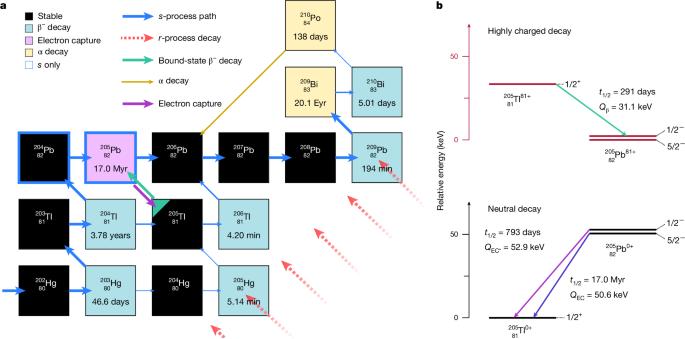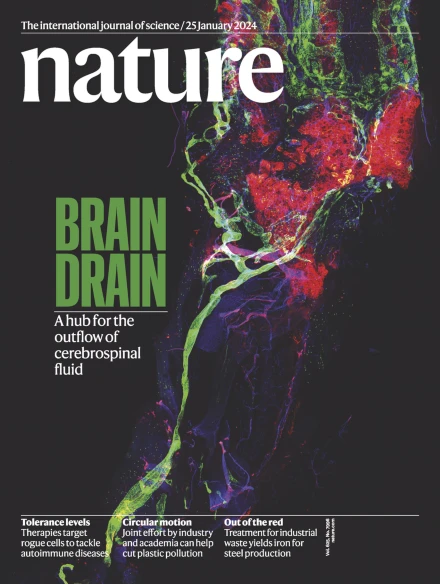High-temperature 205Tl decay clarifies 205Pb dating in early Solar System
IF 48.5
1区 综合性期刊
Q1 MULTIDISCIPLINARY SCIENCES
引用次数: 0
Abstract
Radioactive nuclei with lifetimes on the order of millions of years can reveal the formation history of the Sun and active nucleosynthesis occurring at the time and place of its birth1,2. Among such nuclei whose decay signatures are found in the oldest meteorites, 205Pb is a powerful example, as it is produced exclusively by slow neutron captures (the s process), with most being synthesized in asymptotic giant branch (AGB) stars3–5. However, making accurate abundance predictions for 205Pb has so far been impossible because the weak decay rates of 205Pb and 205Tl are very uncertain at stellar temperatures6,7. To constrain these decay rates, we measured for the first time the bound-state β− decay of fully ionized 205Tl81+, an exotic decay mode that only occurs in highly charged ions. The measured half-life is 4.7 times longer than the previous theoretical estimate8 and our 10% experimental uncertainty has eliminated the main nuclear-physics limitation. With new, experimentally backed decay rates, we used AGB stellar models to calculate 205Pb yields. Propagating those yields with basic galactic chemical evolution (GCE) and comparing with the 205Pb/204Pb ratio from meteorites9–11, we determined the isolation time of solar material inside its parent molecular cloud. We find positive isolation times that are consistent with the other s-process short-lived radioactive nuclei found in the early Solar System. Our results reaffirm the site of the Sun’s birth as a long-lived, giant molecular cloud and support the use of the 205Pb–205Tl decay system as a chronometer in the early Solar System. Measurement of the bound-state β− decay of 205Tl81+ gives a new, longer half-life, allowing for the calculation of accurate stellar 205Pb yields and the isolation time of the early Solar System.


高温 205Tl 衰变澄清了早期太阳系中 205Pb 的年代测定
寿命达数百万年的放射性原子核可以揭示太阳的形成历史,以及太阳诞生时和诞生地发生的活跃核合成1,2。在最古老的陨石中发现衰变特征的这类核中,205Pb 是一个有力的例子,因为它完全是由慢中子俘获(s 过程)产生的,大部分是在渐近巨枝(AGB)恒星中合成的3,4,5。然而,由于 205Pb 和 205Tl 在恒星温度下的弱衰变率非常不确定6,7,因此迄今为止还无法对 205Pb 进行准确的丰度预测。为了限制这些衰变率,我们首次测量了完全电离的 205Tl81+ 的束缚态 β- 衰变,这是一种只发生在高电荷离子中的奇异衰变模式。测得的半衰期比之前的理论估计值长 4.7 倍8 ,而我们 10% 的实验不确定性消除了主要的核物理限制。有了实验支持的新衰变率,我们使用 AGB 恒星模型来计算 205Pb 产率。利用基本银河化学演化(GCE)传播这些产率,并与陨石中的 205Pb/204Pb 比率9,10,11 进行比较,我们确定了太阳物质在其母分子云内部的隔离时间。我们发现正的分离时间与太阳系早期发现的其他 s 过程短寿命放射性核一致。我们的结果再次证实了太阳的诞生地是一个长寿命的巨型分子云,并支持使用 205Pb-205Tl 衰变系统作为早期太阳系的计时器。
本文章由计算机程序翻译,如有差异,请以英文原文为准。
求助全文
约1分钟内获得全文
求助全文
来源期刊

Nature
综合性期刊-综合性期刊
CiteScore
90.00
自引率
1.20%
发文量
3652
审稿时长
3 months
期刊介绍:
Nature is a prestigious international journal that publishes peer-reviewed research in various scientific and technological fields. The selection of articles is based on criteria such as originality, importance, interdisciplinary relevance, timeliness, accessibility, elegance, and surprising conclusions. In addition to showcasing significant scientific advances, Nature delivers rapid, authoritative, insightful news, and interpretation of current and upcoming trends impacting science, scientists, and the broader public. The journal serves a dual purpose: firstly, to promptly share noteworthy scientific advances and foster discussions among scientists, and secondly, to ensure the swift dissemination of scientific results globally, emphasizing their significance for knowledge, culture, and daily life.
 求助内容:
求助内容: 应助结果提醒方式:
应助结果提醒方式:


